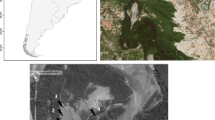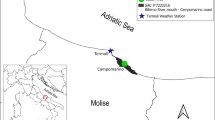Abstract
Wind-tidal flats are the dominant coastal wetland type in southern Texas, USA. Succulent vascular plants are colonizing the flats in some locations, often where past dredge disposal along navigation channels and other activities have interrupted natural water communication between hypersaline bays and large areas of wind-tidal flats. The objective of this study was to test the feasibility of proposed removal of a causeway at Laguna Atascosa National Wildlife Refuge to restore the historic hydrologic regime and eradicate encroaching vascular plants, mostly Salicornia bigelovii, on the assumption that high sediment salt excluded these vascular plants under natural conditions. Assessment in spring 1998 of the density of Salicornia in relation to elevation and sediment salt of bare and vegetated zones on the vegetated flats on one side of the causeway and entirely barren flats with unimpaired connection to Laguna Madre on the other side of the causeway suggested that sediment salt > 0.1 g ml−1 excluded vascular plants. However, bimonthly sampling in 1999–2000 revealed that sediment salt concentrations were > 0.1 g ml−1 throughout the vegetated zone in July and more locally in the period of winter low water, with little impairment to established plants. This indicates that if control is desired, it must be exerted at germination and early establishment during and after fall high water. Continuous monitoring of water levels on either side of the causeway suggests that, even with removal of the causeway, flooding with hypersaline lagoon water will be too infrequent to counteract the freshening effect of a permanent hydraulic connection to the main agricultural drain of the lower Rio Grande Valley that has developed at the other end of the salt flat. Monitoring Salicornia distribution over six years documented huge variation between years but no trend toward increasing dominance of the flats. The results of this study illustrate that the most obvious alterations to a site may not be the most influential on function and that the scale of analysis may have to extend far beyond the site in space and time to evaluate a proposed restoration properly.
Similar content being viewed by others
Literature Cited
Alexander, H. D. and K. H. Dunton. 2002. Freshwater inundation effects on emergent vegetation of a hypersaline salt marsh. Estuaries 25: 1426–1435.
Bertness, M. D., L. Gough, and S. W. Shumway. 1992. Salt tolerances and the distribution of fugitive salt marsh plants. Ecology 73: 1842–1851.
Brown, L. F. Jr., J. L. Brewton, T. J. Evans, T. H. McGowen, W. A. White, C. G. Groat, and W. L. Fisher. 1980. Environmental Geologic Atlas of the Texas Coastal Zone — Brownsville-Harlingen Area. Bureau of Economic Geology, The University of Texas at Austin, Austin, TX, USA.
Brown, L. F. Jr., J. L. Brewton, J. H. McGowen, T. J. Evans, W. L. Fisher and G. Groat. 1977. Environmental Geologic Atlas of the Texas Coastal Zone — Kings ville Area. Bureau of Economic Geology, The University of Texas at Austin, Austin, TX, USA.
Brown, L. F. Jr., J. H. McGowen, T. J. Evans, C. G. Groat, and W. L. Fisher. 1977. Environmental Geologic Atlas of the Texas Coastal Zone — Kingsville Area. Bureau of Economic Geology, The University of Texas at Austin, Austin, TX, USA.
Calloway, J. C. 2001. Hydology and substrate, p. 89–117, In J. B. Zedler (ed.) Handbook for Restoring Tidal Wetlands. CRC Press, Boca Raton, FL, USA.
Chapman, V. J. 1974. Salt Marshes and Salt Deserts of the World. Verlag von Cramer, Lehre, Germany.
Dunton, K. H., B. Hardegree, and T. E. Whitledge. 2001. Response of estuarine marsh vegetation to interannual variation in precipitation. Estuaries 24: 851–861.
Feekes, W. 1936. De ontwikkeling van de natuurlijke vegetatie in die wieringermeer-polder, die eerste groote droogmakerij van der Zuider Zee. Nederlsch Kruidkkundig Archief 46: 1–96.
Hunt, W. G. and F. P. Ward. 1988. Habitat selection by spring migrant peregrines at Padre Island, Texas. p. 527–535, In T. J. Cade, J. H. Enderson, C. G. Thelander, and C. M. White (eds.) Peregrine Falcon Populations: Their Management and Recovery. Peregrine Fund, Inc., Boise, ID, USA.
John, N., W. William, and M. H. Kutner. 1989. Applied Linear Regression Models (2nd Ed.) Irwin Inc., Boston, MA, USA.
Kuhn, N. L. and J. B. Zedler. 1997. Differential effects of salinity and soil saturation on native and exotic plants of a coastal marsh. Estuaries 20: 391–403.
Montgomery, D. C. 1991. Design and Analysis of Experiments (3rd Ed.) John Wiley & Sons Inc., New York, NY, USA.
Nueces River Authority. 2004. www.nueces-ra.org/ Clean Rivers Program, Surface Water Quality Data, Station ID No. 13071.
Quammen, M. L. and C. P. Onuf. 1993. Laguna Madre: seagrass changes continue decades after salinity reduction. Estuaries 16: 302–310.
Rivers, W. G. and D. J. Weber. 1971. The influence of salinity and temperature on seed germination in Salicornia bigelovii. Physiologia Plantarum 24: 73–75.
Ungar, I. A. 1962. Influence of salinity on seed germination in succulent halophytes. Ecology 43: 763–764.
Ungar, I. A. 1978. Halophyte seed germination. The Botanical Review 44: 233–264.
Ungar, I. A. 1995. Seed germination and seed bank ecology in halophytes, p. 599–628, In J. Kigel and G. Galili (eds.) Seed Development and Germination. Marcel Dekker, Inc., New York, NY, USA.
USFWS. 2005. Laguna Atascosa National Wildlife Refuge Wildlife and Habitat Management Review, May 16–21, 2005. Draft report to U.S. Fish and Wildlife Service, National Wildlife Refuge System, Southwest Region, Albuquerque, NM, USA.
Waisel, Y. 1972. Biology of Halophytes. Academic Press, NY, USA.
Withers, K. and J. W. Tunnell, Jr. 1998. Identification of Tidal Flat Alterations and Determination of Effects on Biological Productivity of These Habitats within the Coastal Bend. Corpus Christi Bay National Estuary Program, Corpus Christi, TX, USA. Publication CCBNEP-26.
Zedler, J. B. 2001. Introduction, p. 1–19, In J. B. Zedler (ed.) Handbook for Restoring Tidal Wetlands. CRC Press, Boca Raton, FL, USA.
Zedler, J. B. and P. A. Beare. 1986. Temporal variability of salt marsh vegetation: the role of low salinity gaps and environmental stress, p. 295–306, In D. A. Wolfe (ed.) Estuarine Variability. Academic Press, Inc., Orlando, FL, USA.
Zonick, C. A. 2000. The winter ecology of piping plovers (Charadrius melodus) along the Texas gulf coast. Ph. D. Dissertation. University of Missouri, Columbia, MO, USA.
Zonick, C., K. Drake, J. Thompson, and L. Elliott. The effects of dredged material on piping plovers (Charadrius melodus) and snowy plovers (C. alexandrinus) in the lower Laguna Madre of Texas. Report to U. S. Army Corps of Engineers, Galveston, TX, USA.
Author information
Authors and Affiliations
Corresponding author
Rights and permissions
About this article
Cite this article
Onuf, C.P. Aspects of the biology of Salicornia bigelovii Torr. in relation to a proposed restoration of a wind-tidal flat system on the south Texas, USA coast. Wetlands 26, 649–666 (2006). https://doi.org/10.1672/0277-5212(2006)26[649:AOTBOS]2.0.CO;2
Received:
Revised:
Accepted:
Issue Date:
DOI: https://doi.org/10.1672/0277-5212(2006)26[649:AOTBOS]2.0.CO;2




